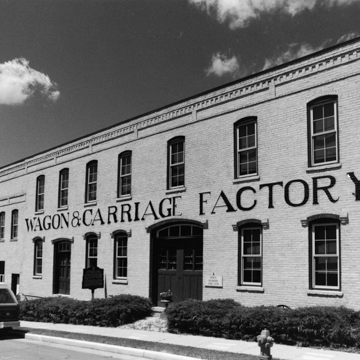This factory is a microcosm of small-scale industrialization, illustrating America’s nineteenth-century transition from cottage-based to factory-based production. Swiss immigrant John Hollenstein moved to Mayville in 1873 and established a business as a wheel-wright and wagon maker. Within three years, he erected either his house, the original portion of the factory, or both. Like many tradesmen who became factory owners, Hollenstein attached his place of business to his home, and he boarded several of his employees, perpetuating a traditional artisan-apprentice relationship and a pre-industrial connection between workshop and family life. Within a decade, demand for Hollenstein’s vehicles had grown enough to warrant a major expansion. He erected a 40 × 66–foot addition in 1888; two years later, he added a two-story powerhouse with a ten-horsepower steam engine to the north side. He prospered until the 1910s, when mass production of automobiles and trucks rendered his business obsolete.
Each stage of growth is clearly visible on the building. At one end stands Hollenstein’s two-story post-and-beam house, a vernacular, side-gabled structure. Originally clad in clapboard, the house acquired a cream brick veneer to match the factory. Large segmental-arched windows light the house, and a full-width veranda with dentils and scroll brackets spans the facade. The factory’s oldest portion, adjoining the house on the east, is a two-story cream brick structure with a flat roof and segmental-arched windows. Brick string-courses mark the original roofline. When Hollenstein added the largest portion of the factory, again using cream brick, he raised the roof of the old building and visually tied the old and new structures together with a corbel table. On the north side of the complex are the last two additions, including the two-story powerhouse, which has lost its boiler, engine, and smokestack. The painted legend “Wagon & Carriage Factory” replicates the original sign. The Mayville Historical Society now operates the complex as an industrial museum.





















